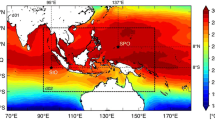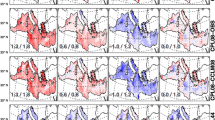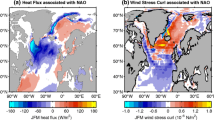Abstract
The near-sea surface meteorological conditions associated with the Mediterranean heavy precipitation events constitute, on a short time scale, a strong forcing on the ocean mixed layer. This study addresses the question of the optimal time frequency of the atmospheric forcing to drive an ocean model in order to make it able to capture the fine scale ocean mixed layer response to severe meteorological conditions. The coupling time frequency should allow the ocean model to reproduce the formation of internal low-salty boundary layers due to sudden input of intense precipitation, as well as the cooling and deepening of the ocean mixed layer through large latent heat fluxes and stress under the intense low-level jet associated with these events. In this study, the one-dimensional ocean model is driven by 2.4-km atmospheric simulated fields on a case of Mediterranean heavy precipitation, varying the time resolution of the atmospheric forcing. The results show that using a finer temporal resolution than 1 h for the atmospheric forcing is not necessary, but a coarser temporal resolution (3 or 6 h) modifies the event course and intensity perceived by the ocean. Consequently, when using a too coarse temporal resolution forcing, typically 6 h, the ocean model fails to reproduce the ocean mixed layer fine scale response under the heavy rainfall pulses and the strong wind gusts.








Similar content being viewed by others
References
Alexander MA, Scott JD, Deser C (2000) Processes that influence sea surface temperature and ocean mixed layer depth variability in a coupled model. J Geophys Res 105(C7):16823–16842
Ayoub N, Lucas M, Barnier B, Penduff T, Valladeau G, De Mey P (2006) A study of model errors in surface layers due to uncertainties in the atmospheric fields. Mercator Ocean Q Newsl 22:29–38
Bahurel P, Dombrowsky E, Lellouche J-M, and the Mercator project team (2004) Mercator ocean monitoring and forecasting system, near-realtime assimilation of satellite and in-situ data in different operational ocean models. In: 36th international Liège Colloquium on ocean dynamics, Liège, April 2004 (preprints)
Barnier B, Brodeau L, Penduff T (2006) News: ocean surface forcing and surface fields. Mercator Ocean Q Newsl 22:4–7
Bernie DJ, Woolnough SJ, Slingo JM, Guilyardi E (2005) Modeling diurnal and intraseasonal variability of the Ocean Mixed Layer. J Clim 18:1190–1202
Blanke B, Delecluse P (1993) Variability of the tropical Atlantic ocean simulated by a general circulation model with two different mixed-layer physics. J Phys Oceanogr 23:1363–1388
Brainerd KE, Gregg MC (1995) Surface mixed and mixing layer depths. Deep-sea Res Part I 42:1521–1543
Brandt P, Funk A, Czeschel L, Eden C, Boning CW (2007) Ventilation and transformation of labrador sea water and its rapid export in the deep Labrador current. J Phys Oceanogr 37:946–961
Ducrocq V, Ricard D, Lafore J-P, Orain F (2002) Storm-scale numerical rainfall prediction for five precipitating events over France: on the importance of the initial humidity field. Weather Forecast 17(6):1236–1256
Ekman VW (1905) On the influence of the Earth’s rotation on ocean currents. Ark Mat Astron Fys 2:1–53
Estournel C, Durrieu de Madron X, Marsaleix P, Auclair F, Julliand C, Vehil R (2003) Observation and modelling of the winter coastal oceanic circulation in the Gulf of Lion under wind conditions influenced by the continental orography (FETCH experiment). J Geophys Res 108(C3):8059. doi:10.1029/2001JC000825.
Fairall CW, Bradley EF, Hare JE, Grachev AA, Edson JB (2003) Bulk parameterization of air-sea fluxes : updates and verification for the COARE algorithm. J Climate 16:571–591
Gaspar P, Grégoris Y, Lefevre J-M (1990) A simple Eddy Kinetic Energy model for simulations of the oceanic vertical mixing: tests at station papa and long-term upper ocean study site. J Geophys Res 95(C9):16179–16193
Giordani H, Caniaux G, Prieur L, Paci A, Giraud S (2005) A 1 year mesoscale simulation of the northeast Atlantic: mixed layer heat and mass budgets during the POMME experiment. J Geophys Res 110:C07S08. doi:10.1029/2004JC002765.
Giordani H, Prieur L, Caniaux G (2006) Advanced insights into sources of vertical velocity in the ocean. Ocean Dyn 56:513–524
Herrmann M, Somot S (2008) Relevance of ERA40 dynamical downscaling for modeling deep convection in the North-Western Mediterranean Sea. Geophys Res Lett 35:L04607. doi:10.1029/2007GL032442.
Hontarrède M, Jourdan R, Vaysse F, Valantin P-Y (2004) Tempête dans le golfe du lion. Metmar 203:6–9
Lafore J-P, Stein J, Asencio N, Bougeault P, Ducrocq V, Duron J, Fischer C, Héreil P, Mascart P, Masson V, Pinty J-P, Redelsperger J-L, Richard E, Vilà-Guerau de Arellano J (1998) The Meso-NH atmospheric simulation system. Part I: adiabatic formulation and control simulations. Scientific objectives and experimental design. Ann Geophys 16(1):90–109
Lebeaupin C, Ducrocq V, Giordani H (2006) Sensitivity of Mediterranean torrential rain events to the sea surface temperature based on high-resolution numerical forecasts. J Geophys Res 111:D12110. doi:10.1029/2005JD006541.
Lebeaupin Brossier C, Ducrocq V, Giordani H (2008) Sensitivity of three Mediterranean heavy rain events to two different sea surface fluxes parameterizations in high-resolution numerical modeling. J Geophys Res 113:D21109. doi:10.1029/2007JD009613.
Lebeaupin Brossier C, Ducrocq V, Giordani H (2009) Two-way one-dimensional high-resolution air–sea coupled modelling applied to Mediterranean heavy rain events. Q J R Meteorol Soc 135:187–204
Li L, Bozec A, Somot S, Béranger K, Bouruet-Aubertot P, Sevault F, Crépon M (2006) Regional atmospheric, marine processes and climate modelling. In: Lionello P, Malanotte-Rizzoli P, Boscolo R (eds) Mediterranean climate variability and predictability. Elsevier, Amsterdam, pp 373–397
Mlawer EJ, Taubman SJ, Brown PD, Iacono MJ, Clough SA (1997) A validated correlated-k model for the longwave. J Geophys Res 102:16663–16682
Nuissier O, Ducrocq V, Ricard D, Lebeaupin C, Anquetin S (2008) A numerical study of three catastrophic precipitating events over Western Mediterranean region (Southern France). Part I: numerical framework and synoptic ingredients. Q J R Meteorol Soc 134:111–130
Paci A, Caniaux G, Gavart M, Giordani H, Lévy M, Prieur L, Reverdin G (2005) A high-resolution simulation of the ocean during the POMME experiment: simulation results and comparison with observations. J Geophys Res 110:C07S09. doi:10.1029/2004JC002712
Paci A, Caniaux G, Giordani H, Lévy M, Prieur L, Reverdin G (2007) A high-resolution simulation of the ocean during the POMME experiment: mesoscale variability and near surface processes. J Geophys Res 112:C04007. doi:10.1029/2005JC003389
Pinty J-P, Jabouille P (1998) A mixed-phase cloud parameterization for use in a mesoscale non-hydrostatic model: simulations of a squall line of orographic precipitation. In: Conference on cloud physics. American Meteorological Society, Everett, pp 217–220
Xing J, Davies AM, Fraunié P (2004) Model studies of near-inertial motion on the continental shelf off norteast Spain: a three-dimensional/two-dimensional/one-dimensional model comparison study. J Geophys Res 109:C01017. doi:10.1029/2003JC001822
Acknowledgements
This work has been sponsored by the “CYclogénèse et PRécipitations Intenses en Méditerranée” (CYPRIM) project of the program ACI-FNS “Aléas et Changements Globaux” of the French research ministry. The authors would like to thank the two anonymous journal reviewers for their constructive comments.
Author information
Authors and Affiliations
Corresponding author
Additional information
Responsible Editor: Richard John Greatbatch.
Rights and permissions
About this article
Cite this article
Lebeaupin Brossier, C., Ducrocq, V. & Giordani, H. Effects of the air–sea coupling time frequency on the ocean response during Mediterranean intense events. Ocean Dynamics 59, 539–549 (2009). https://doi.org/10.1007/s10236-009-0198-1
Received:
Accepted:
Published:
Issue Date:
DOI: https://doi.org/10.1007/s10236-009-0198-1




